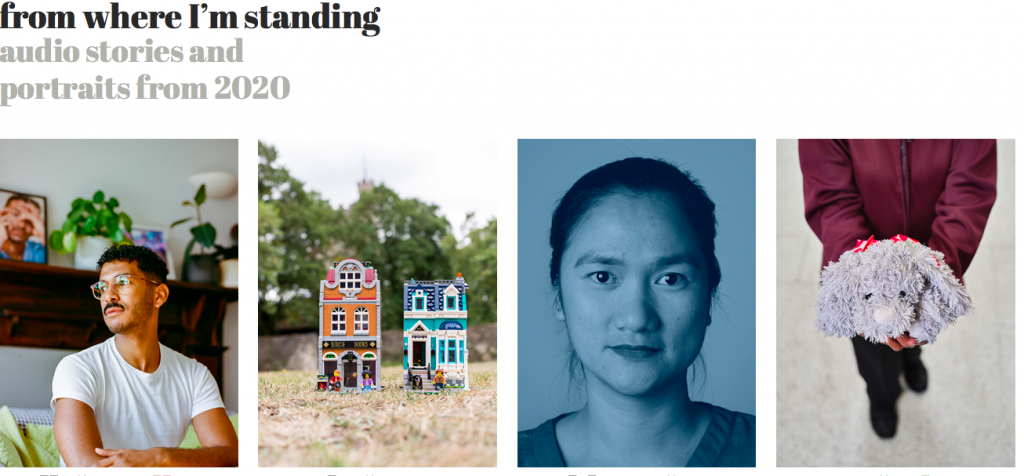Founder of the Empathy Museum Clare Patey talks about their latest exhibition ‘From Where I’m Standing’

The NHS have played a significant role in tackling the Covid pandemic, their efforts crucial to the nation’s recovery from the crisis. Giving voice to the experiences of those who work within the medical profession, founder of the Empathy Museum Clare Patey talks about the organisation’s latest initiative – From Where I’m Standing. Both a physical and online exhibition, the initiative showcases 34 real life stories from the pandemic, audio clips further expanding on the participants experiences. Currently available to view and listen to, Clare tells us more about the exhibition which serves as an important historical archive of this year.
Hi Clare, you’re the founder of the Empathy Museum who are currently presenting ‘From Where I’m Standing’ which is now live to view online. How does it feel to have the exhibition available to view?
Firstly, it’s available to view online which is fantastic because we can be in contact with a global audience and it also means that we can share the photographs and experiences of the people that have taken part together in one place as a virtual gallery. Secondly, I think it’s important that it’s available to view as a physical exhibition and I feel really proud that we have been able to do that at a time where cultural organisations have had to close their doors and even if they are open, they are limited to the amount of people that can come in. Putting this exhibition on in a public space and putting these stories on display with each one being hosted by someone that lives on a particular street increases the connections between the participant, the photographer, the audio producer, the person whose house it is and the viewer.
Created in collaboration with the NHS and The Health Foundation, From Where I’m Standing tells the diverse stories of people around the UK, serving as a record of life in 2020. What inspired this collaboration?
We wanted to bring the voices of people who are having a very particular experience of the pandemic to a wider audience. Obviously, people have had different experiences, some have been ill or lost loved ones and it’s been stressful and anxiety making for many. The project was about thinking about the difference in people’s experiences at this particular time. For instance, I’ve been sitting here in my house working from home and I’ve got no idea what it’s like to be a therapist from Birmingham or an undertaker from Devon or a student who has had their A-levels cancelled and missed out their place at Uni. I think there’s very extreme experiences at this time that we are not all able to have an insight into and the Empathy Museum is all about giving the people the chance to see the world through somebody’s eyes and we wanted to bring that experience into people’s home through a web gallery and in a physical space.
The exhibition is made of 34 portraits, each accompanied with audio stories and an image of an object that reflects this time period for each person featured. How was it decided what stories were featured and how have you found creating an exhibition for our digital era?
We worked closely with NHS England and with The Health Foundation, both of whom we have worked with before, and through their networks participants were suggested and we talked to hundreds and we then tried to whittle it down in terms of peoples’ experience, roles and where they were based in the UK so that we got a diversity of experience from a domestic work to a chaplain to an ICU doctor. We also worked with our local community where we are based in Brixton and asked local people to nominate someone who had made a difference to them during lockdown. We also decided to focus on people who had a very particular experience, for instance someone that is blind and having to work from home or a rapper trying to create during lockdown.
From Where I’m Standing has 4 strands shot by 4 award winning photographers – Why was it important to approach the exhibition focusing on these particular strands?
Early on it was about getting people who had had a particular experience during the pandemic, and we wanted a diverse set of voices from around the UK. Due to the collaboration we wanted to work with stories from health, social care and nursing. We wanted a local strand to reflect where we are based and work with our community but also because the world has become hyperlocal as we have been locked down at home and you notice those local heroes and the community around you. The last strand was because we wanted to have a diverse set of voices of people who were experiencing a very particular set of problems due to the pandemic, like the student and the undertaker.
What can viewers expect from the exhibition and what would you like for viewers to take away from the exhibition?
Regarding the physical exhibition, I like the fact that it’s in a public space so you might happen upon it by chance. The physical exhibition is an intervention into a public space that might be surprising, and you will be able to experience outside of a cultural space and it’s available for anyone for free to come and see. It’s also playing with the idea of who we celebrate in a public space and who hosts it, our venue partners are the neighbours in the street. Through the virtual gallery and the in-person instalment, people can expect a series of powerful stories from an amazing group of people who express a culture of care and I think that that is one of the most positive things that has come out of this crisis – the authenticity, the hard work, the wisdom, the humour often and the care of the people who are undertaking often quite difficult jobs during this time. I think it is important for all of us to listen to those voices, to know about their experiences and to empathise with them.
 Questions by Lucy Basaba.
Questions by Lucy Basaba.
From Where I’m Standing is currently available to view here…


Leave a Comment